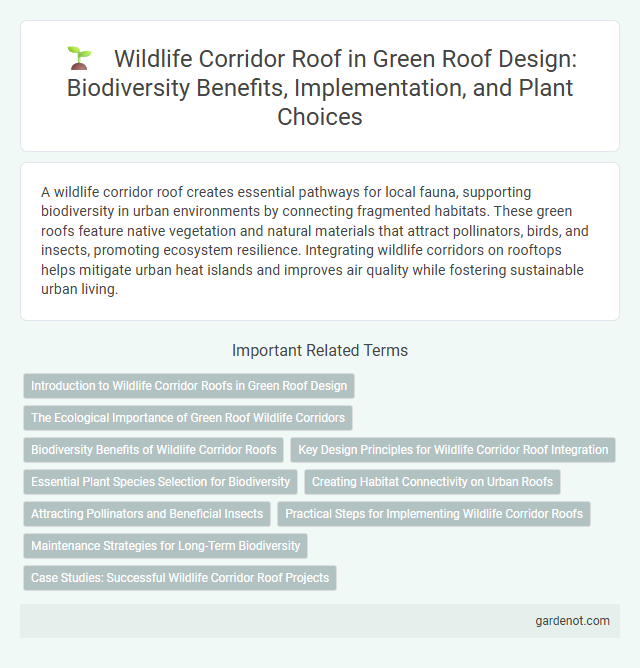A wildlife corridor roof creates essential pathways for local fauna, supporting biodiversity in urban environments by connecting fragmented habitats. These green roofs feature native vegetation and natural materials that attract pollinators, birds, and insects, promoting ecosystem resilience. Integrating wildlife corridors on rooftops helps mitigate urban heat islands and improves air quality while fostering sustainable urban living.
Introduction to Wildlife Corridor Roofs in Green Roof Design
Wildlife corridor roofs integrate green roof technology with ecological pathways to facilitate safe animal movement across urban landscapes. These roofs feature native vegetation and habitat structures designed to support pollinators, birds, and small mammals, enhancing biodiversity in densely built environments. Incorporating wildlife corridors in green roof design mitigates habitat fragmentation and promotes ecosystem connectivity essential for urban wildlife survival.
The Ecological Importance of Green Roof Wildlife Corridors
Green roof wildlife corridors serve as critical habitats that support biodiversity in urban environments by connecting fragmented ecosystems and allowing safe movement for birds, insects, and small mammals. Their ecological importance lies in enhancing species diversity, promoting pollination, and maintaining gene flow between isolated populations. These corridors mitigate urban heat island effects and improve air quality, contributing to healthier urban ecosystems.
Biodiversity Benefits of Wildlife Corridor Roofs
Wildlife corridor roofs create vital habitats that support diverse species by connecting fragmented urban ecosystems, enhancing biodiversity in densely built environments. These green roofs provide essential resources such as food, shelter, and nesting areas for pollinators, birds, and small mammals, promoting ecological resilience. Incorporating native plants and varied vegetation structures on wildlife corridor roofs significantly boosts species richness and ecosystem services in urban landscapes.
Key Design Principles for Wildlife Corridor Roof Integration
Wildlife corridor roofs should prioritize native vegetation selection to support local biodiversity and create continuous habitats for species movement. Structural elements must include safe passageways, such as layered plantings and varied topography, facilitating connectivity between green spaces. Incorporating water sources and shelter niches enhances the suitability and functionality of the corridor for diverse wildlife populations.
Essential Plant Species Selection for Biodiversity
Selecting essential plant species for a wildlife corridor roof involves prioritizing native, flowering plants that provide food and habitat for pollinators such as bees, butterflies, and birds. Incorporating a diverse mix of perennials, grasses, and shrubs ensures seasonal resources and supports various wildlife life cycles. Emphasis on drought-tolerant, low-maintenance species enhances ecosystem resilience and sustainability in urban environments.
Creating Habitat Connectivity on Urban Roofs
Wildlife corridor roofs enhance urban biodiversity by linking fragmented habitats through green roof networks. These designs promote movement and genetic exchange for pollinators, birds, and small mammals, supporting resilient ecosystems within cities. Incorporating native vegetation and structural diversity maximizes habitat connectivity and ecological functionality on urban rooftops.
Attracting Pollinators and Beneficial Insects
Wildlife corridor green roofs create vital habitats that attract pollinators such as bees, butterflies, and hummingbirds by providing diverse native flowering plants rich in nectar and pollen. These ecosystems support beneficial insects like ladybugs and lacewings, which naturally control pests, enhancing urban biodiversity and reducing the need for chemical interventions. Integrating varied plant species and structural features on the roof fosters a continuous habitat network, promoting ecological connectivity within dense city environments.
Practical Steps for Implementing Wildlife Corridor Roofs
Wildlife corridor roofs enhance urban biodiversity by connecting fragmented habitats through strategically designed green spaces that support native flora and fauna. Practical steps for implementing these roofs include selecting indigenous plant species that provide food and shelter, designing interconnected pathways for animal movement, and incorporating structural features like nesting boxes or logs to accommodate various wildlife. Regular monitoring and maintenance ensure the corridor's ecological functionality and resilience in urban environments.
Maintenance Strategies for Long-Term Biodiversity
Wildlife corridor roofs require tailored maintenance strategies such as regular native plant inspections, invasive species removal, and seasonal pruning to sustain habitat quality and promote biodiversity. Implementing adaptive management plans based on monitoring data ensures the roof continues to support diverse species over time. Soil health maintenance through organic mulching and controlled irrigation further enhances long-term ecological resilience.
Case Studies: Successful Wildlife Corridor Roof Projects
Wildlife corridor roof projects, such as the Vancouver Convention Centre living roof and the Singapore National Library green roof, demonstrate effective integration of native vegetation to support urban biodiversity. These case studies showcase increased habitat connectivity for pollinators and bird species, reducing the ecological fragmentation caused by city infrastructure. Monitoring reports reveal significant improvements in local wildlife movement and habitat quality, validating the ecological benefits of wildlife corridor roofs in urban environments.
Wildlife corridor roof Infographic

 gardenot.com
gardenot.com